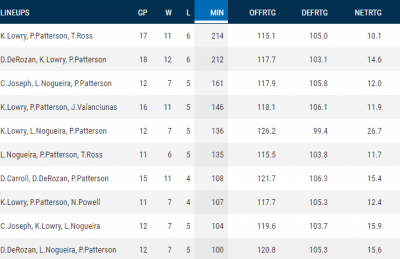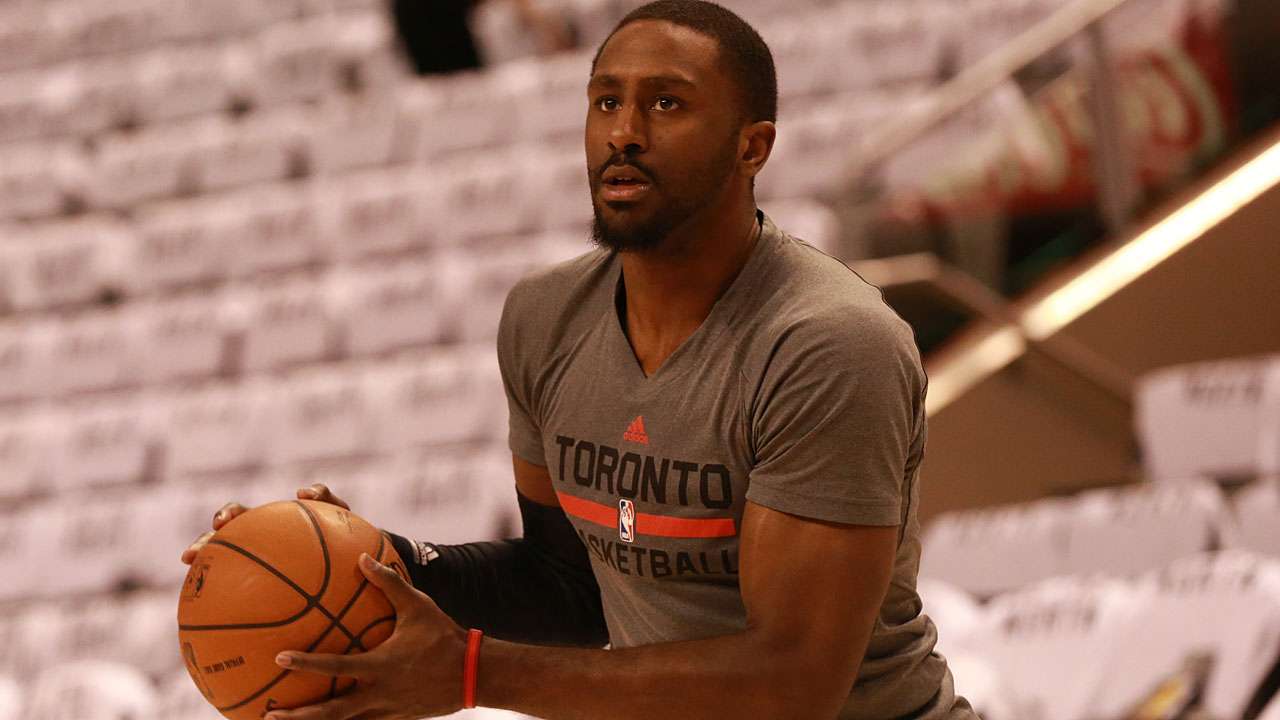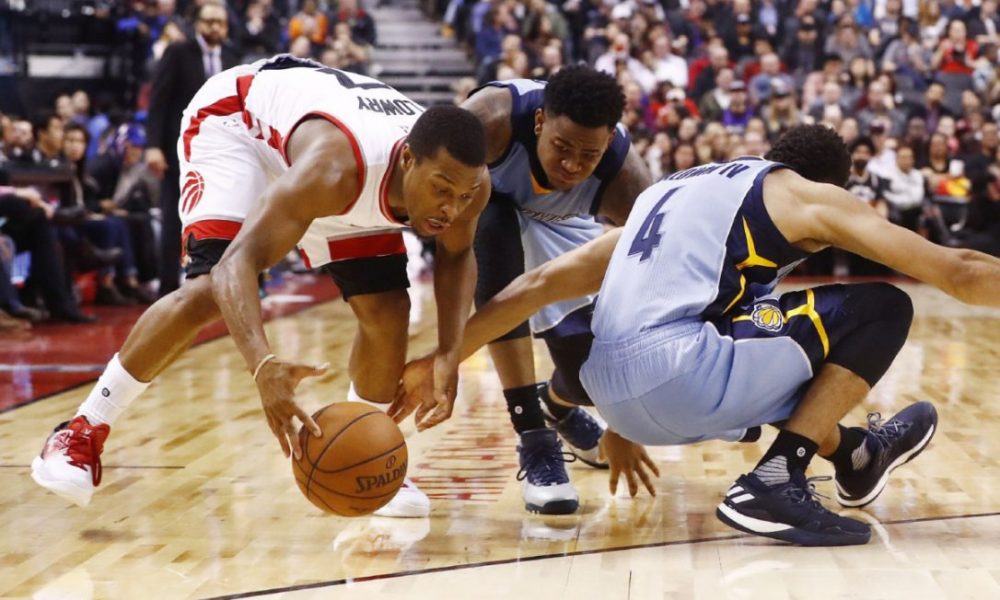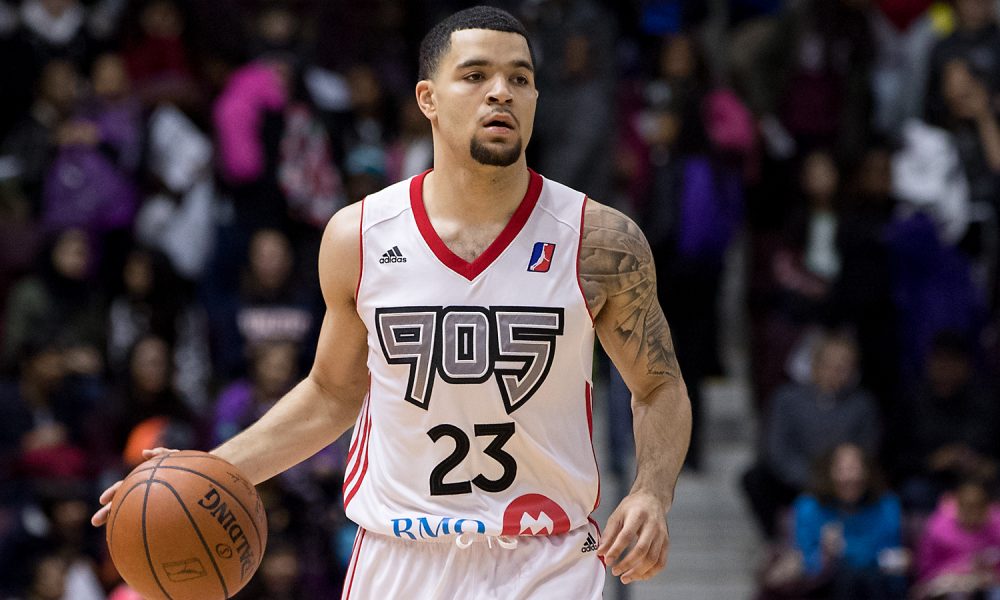The Internet told me the Raptors need an upgrade at starting power forward. The guy to fill that whole just doesn’t exist on the roster, and they can’t be a truly elite team without the right player there. This, after all, is what’s holding the team back from being revered in the company of teams like Cleveland and Golden State. So they said. Solving this issue required critical thinking, so you should start by making a list of things you’d want in an ideal starting power forward for the squad.
You definitely need to start with solid defense, because Jonas Valanciunas and DeMar DeRozan can slack at times on that end of the floor, and you might need the other guys on the floor to assist in covering holes created. You also need someone to space the floor, someone who can hit an open 3-pointer, and also require defensive attention to open up space for DeRozan and Lowry’s drives into the paint, make sure the opposing team can’t converge on them too quickly and will be punished if they commit too hard. The ideal player for this role, however, won’t require or demand the ball, so the offense can still run through the guards and Jonas Valanciunas, who’s growth has demanded more offensive possessions be given to him on the inside. A good passer would be nice, and someone who brings chemistry to the team and is a good locker room presence. If possible, have the player in question also love the city of Toronto.
| Totals | Advanced | ||||||||||||||||||||||
|---|---|---|---|---|---|---|---|---|---|---|---|---|---|---|---|---|---|---|---|---|---|---|---|
| Rk | Player | Ht | Season | Age | Tm | Lg | G | GS | MP | 3PAr | TRB% | USG% | ORtg | DRtg | OWS | DWS | WS | WS/48 | OBPM | DBPM | BPM | VORP | 3P |
| 1 | Al Horford | 6-10 | 2015-16 | 29 | ATL | NBA | 82 | 82 | 2631 | .244 | 12.4 | 20.6 | 113 | 101 | 4.9 | 4.5 | 9.4 | .172 | 1.5 | 2.6 | 4.1 | 4.1 | 1.1 |
| 2 | Paul George | 6-9 | 2015-16 | 25 | IND | NBA | 81 | 81 | 2819 | .391 | 10.9 | 30.4 | 106 | 101 | 4.4 | 4.8 | 9.2 | .157 | 3.5 | 1.0 | 4.5 | 4.6 | 2.6 |
| 3 | Kevin Love | 6-10 | 2015-16 | 27 | CLE | NBA | 77 | 77 | 2424 | .449 | 17.8 | 23.4 | 112 | 102 | 4.7 | 3.8 | 8.5 | .169 | 1.7 | 0.9 | 2.5 | 2.8 | 2.1 |
| 4 | Marvin Williams | 6-9 | 2015-16 | 29 | CHO | NBA | 81 | 81 | 2338 | .506 | 12.2 | 16.8 | 118 | 104 | 4.7 | 3.2 | 7.8 | .161 | 1.7 | 1.0 | 2.7 | 2.7 | 1.9 |
| 5 | Luol Deng | 6-9 | 2015-16 | 30 | MIA | NBA | 74 | 73 | 2394 | .344 | 10.5 | 17.4 | 112 | 105 | 3.5 | 2.8 | 6.4 | .128 | 1.3 | 0.6 | 1.9 | 2.3 | 1.2 |
| 6 | Marcus Morris | 6-9 | 2015-16 | 26 | DET | NBA | 80 | 80 | 2856 | .315 | 7.7 | 18.4 | 107 | 108 | 2.9 | 2.5 | 5.4 | .091 | 0.2 | 0.5 | 0.7 | 2.0 | 1.4 |
| 7 | Kristaps Porzingis | 7-3 | 2015-16 | 20 | NYK | NBA | 72 | 72 | 2047 | .274 | 14.0 | 24.6 | 103 | 103 | 1.5 | 2.9 | 4.3 | .102 | -0.8 | 0.9 | 0.1 | 1.1 | 1.1 |
| 8 | Al-Farouq Aminu | 6-9 | 2015-16 | 25 | POR | NBA | 82 | 82 | 2341 | .485 | 11.5 | 16.9 | 105 | 107 | 1.7 | 2.3 | 4.0 | .082 | -0.4 | 0.7 | 0.2 | 1.3 | 1.5 |
| 9 | Patrick Patterson | 6-9 | 2015-16 | 26 | TOR | NBA | 79 | 0 | 2020 | .594 | 9.7 | 12.9 | 108 | 107 | 1.6 | 2.0 | 3.6 | .086 | 0.4 | 0.6 | 1.0 | 1.5 | 1.3 |
To start with, there were nine forwards above 6’9″ in height last season who hit at least one three pointer per game while having a DBPM over 0.5. Of those nine players, Luol Deng and Al-Farouq Aminu can be removed immediately because they aren’t good fits at power forward in most lineups. Now you’re left with Al Horford, Paul George, Kevin Love, Marvin Williams, Marcus Morris, Kristaps Porzingis and Patrick Patterson. Horford and Williams just signed new contracts with their current teams, who seem to be in win now mode, so they probably aren’t available via trade. Kevin Love was a key piece on the reigning NBA champions, and likely isn’t on the trading block. Kristaps Porzingis is one of the best young players in the entire league, and even if he was available, the price tag would likely put him out of reach for Toronto, and the same can likely be said about Paul George who is the centerpiece in Indiana. That leaves Patrick Patterson and Marcus Morris. Morris might be available, and he’s a talented young player who can stretch the floor as well as play the four, but his mercurial personality might not be worth it, and Patterson is already on the roster and is the better glass cleaner. This isn’t to say Patterson is as skilled as some of the names on the list, merely that he also fits the criteria that the Raptors should be looking for in a starter at that position.
Going back to that list, one thing that should stand out is the fact that aside from Patterson, the remaining 8 players played one total game where they did not start last season. These are starting quality players, because this is a high demand skill set and one that fits in with most rosters. With Patterson, he doesn’t have the obvious impact of some of the other guys on the list, and he doesn’t often make flashy plays. His shooting can be inconsistent, but his value tends to go far beyond his personal statistics. For the first 18 games of this young NBA season, there have been 28 3-man lineups for the Raptors that have breached the 100-minute mark, and of those, 10 lineups have a net rating above +10. Nine of those ten lineups feature Patterson, and the tenth lineup is the group of Cory Joseph, Kyle Lowry, and Lucas Noguiera, a 3-man unit that has totalled 104 minutes, and Patterson has played 102 of those minutes.(and the net rating goes from +15.9 in their 104 minutes to +19.1 in the 102 minutes of the 4-man unit with Patterson)

So if we establish that Patterson is incredibly valuable and important to the team, the next question would be whether he needs to start. After all, the organization has said time and again that Patterson is more comfortable coming off the bench, and as long as he’s playing the crunch time minutes, that should be what matters most, right? It’s not that simple. First of all, with Patterson averaging 29.5 minutes per game this season, it’s clear the team values his contributions and has set out to maximize his time on the court. However, this is where it gets complicated. With starting players, there are two types of minutes. You’re either playing or resting, and the goal is to use the resting minutes to maximize both the playing minutes and the contributions during those times on the court. By moving the player out of the starting lineup, you create a third set of minutes, which I’ll call ‘idle minutes’. For Patterson, this is the first 6 or so minutes of either half when he’s sitting on the bench but hasn’t exerted himself yet to need rest. These minutes serve neither purpose, in that he’s neither contributing to the team on the court, and he’s also not resting to maximize his on-floor contributions. Not only that, by sitting these 6 minutes of each half, he’s down to 36 possible minutes in the game in which to get his 30 minutes, meaning that he has to play 15 of the remaining 18 minutes in either half, on average. This means that he’s spending at least some minutes on the floor every night more tired than he needs to be, and that’s to the detriment of the team.(although this is hard to see in terms of impact statistics because his numbers are already so good)
Also, to put this in perhaps the simplest form, the starting lineup simply works better with Patterson. This isn’t intended as a knock on Pascal Siakam, who’s been a revelation this season and far exceeded what most would’ve expected from a player drafted 27th overall. However, Siakam makes some rookie mistakes and doesn’t space the floor as well as Patterson, does, leading to a crowded paint at times. This was true last year as well, when the group of DeRozan, Lowry, Carroll and Valanciunas played better with Patterson than they did with starter Luis Scola. It was an adjustment the team tried to make during the playoff run, but the bench units struggled to find rhythm without Patterson, as they hadn’t had a chance to adjust prior to the grueling postseason competition.

The next issue to address then is, if Patterson is starting, how do you still maintain those important and valuable Lowry and the bench lineups which have been critical to the team’s success both this year and last? First of all, if you bring the starting lineup up to being a net positive, which his addition should do, you won’t need as much from those bench groups, and secondly, you can send Patterson to the bench around the halfway mark of the first quarter, changing those first 12 minutes from rest minutes to playing minutes, then use the second half of the first quarter as rest minutes for him, and bring him back in to start the second and fourth quarters in the normal slot of the Lowry and the bench group, with Patterson rested. Now in order to get his usual 30 minutes a night, he also only needs to play 9 of the 12 minutes in the second quarter. Also, it’s important to do this during the regular season, if it will be done. Last year the team attempted to move Patterson to the starting lineup during the playoffs, and while the starters did improve and play well during the games he started, the bench struggled without his presence. By making this adjustment earlier in the year, you give those bench units time to adjust to his absence and find a way to succeed anyways. This is a deep Raptors team, and they have the talent in the reserves to succeed despite his absence.
While the temptation will likely remain to suggest the team needs to go out and get an All-Star power forward whether or not Patterson is in the starting group, and any opportunity to add a significant upgrade should definitely be pursued, the solution seems to be on the team without giving up assets, and it just makes sense to pursue the internal solution before determining you need an external one. For what it’s worth, Patterson also loves the city, and it’d be a shame to let such a player go, one who contributes to the team and fits so well, without at least giving him the opportunity. Patterson himself has maintained that he is more comfortable coming off the bench, but at least in training camp prior to last season, he seemed to think the job was his to lose.



